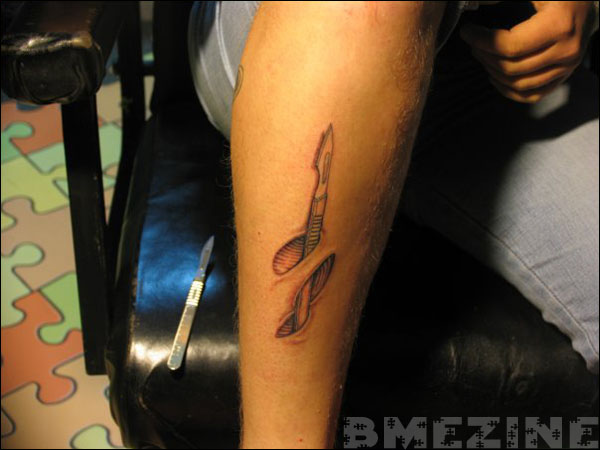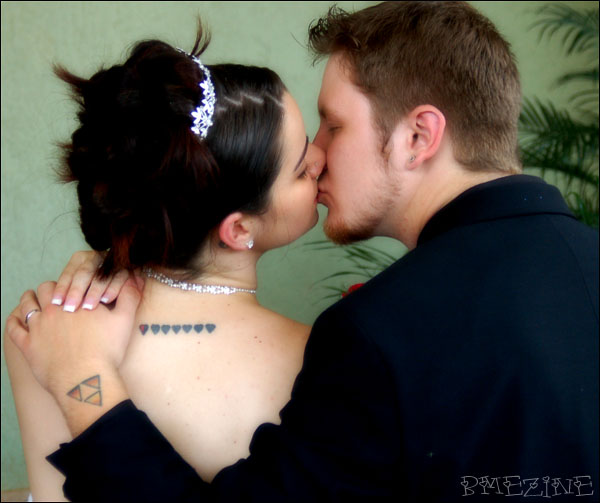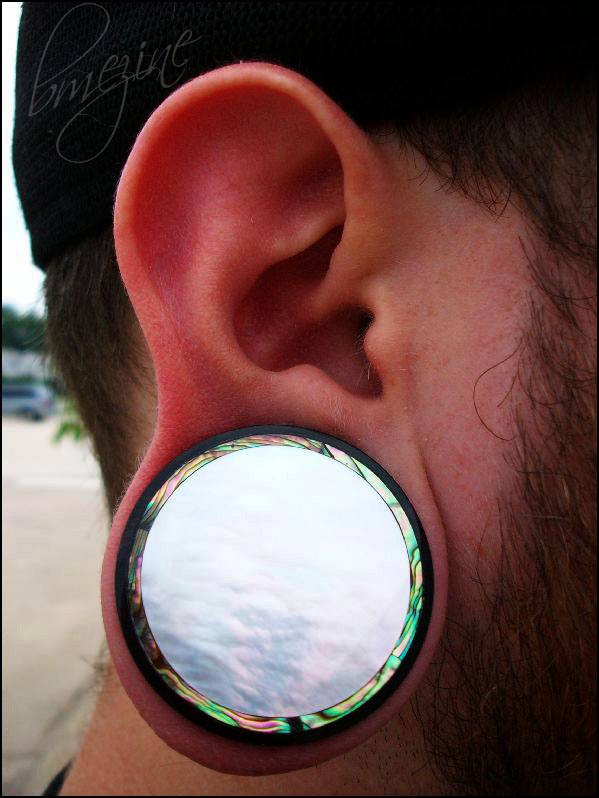DAnik‘s already got a pair of forceps under his skin so I doubt a scalpel will make matters worse..

Loving the floor tiles, by the way!
DAnik‘s already got a pair of forceps under his skin so I doubt a scalpel will make matters worse..

Loving the floor tiles, by the way!
(Editor’s note: This article was first published in The Point, the publication of the Association of Professional Piercers, on March 14, 2002. Since part of BME’s mandate is to create as comprehensive and well rounded an archive of body modification as possible, we feel these are important additions.
Paul King, the article’s author, has given BME permission to publish a series of articles he wrote for The Point that explore the anthropological history behind many modern piercings. This is another in that series.)
Female infibulation, as defined by this article, involves multiple piercings of the outer labia. It does not include excision of the clitoris, clitoral hood and/or labia minora. Most western women today who wear outer labia piercings do so by choice to increase both aesthetic and physical pleasure. In western fetish communities, in which outer labia piercings are performed for chastity play, the process is mutually consensual. Many piercers today find outer labia piercings heal quicker and with fewer problems by using barbells, curved or straight, instead of rings.

Historically, the piercing was often performed with a needle followed by thread until it healed, though sometimes the rings would be directly inserted after or as part of the piercing process. A single ring or suture would pass through both outer labia, pulling them together and obstructing access of the vagina.
THROUGH HISTORY
“Roman reference in the fifth century B.C.E., Herodotus says Ethiopians performed infibulation freely on wives. Rhodius and Fabricius d’ Aquapendente refer to the use of infibulation for preservation of chastity. Celsus states that among Romans occasionally posterior piercing was performed to prevent access from the rear as well.”1
In 1737 in Leicester, England, George Baggerley was fined 20 schillings for sewing his wife’s outer labia together with needle and thread.2
“In some other tribes in Asia and Africa, they run a ring through the tips of the opposite nymph; and this ring is so encased in girls, that it can be removed only by filing it, or forcibly cutting it with scissors. We can imagine those shackles can be welded only by soldering, so as to unite the branches of the buckle after it has been sunk into the flesh; and this soldering can be performed only with a red-hot iron, which is laid on the buckle itself, in order to melt in the ore lead. As to the women they wear there an iron circle provided with a lock, the key of which the husband holds; for this tool supplies the place of seraglio and eunuchs, who require such expense and who cost so dear in Asia, that absolutely nobody but seigniors and princes have slaves trained for guarding other slaves; villains from among the population use those rings we have just spoken about.”3 Some writings, such as the previous passage, suggest that the rings were sometimes soldered shut, though an eyewitness account of this supposed process has remained elusive.
Fakir Musafar provides an Indian reference: “Tamil suitors used to demand the sewing up of the outer labia until marriage with the use of gold wire.”4
“It is not possible to conclude whether there was one origin or several independent origins. [Some] feel that there is sufficient evidence to assume that infibulation was practiced in ancient Egypt, and that perhaps it is there the custom originated. Or it could have been an old African puberty rite that came to Egypt by diffusion. (Infibulation is known in the Sudan as ‘Pharaonic circumcision’ and in Egypt it is referred to as ‘Sudanese circumcision.’)”5

This author is opposed to any form of nonconsensual genital mutilation, whether on infant boys in the U.S. or on women and young girls in some traditional African societies and extremist Muslim groups throughout the world. The practices of foreskin and clitoral hood circumcision, clitoridectomy, excision and abrasion of the vulva area followed by suturing together of both outer labia until the vaginal opening heals shut, are forced on hundreds of thousands of children today. For more information on these practices or to learn how you can help fight these human rights abuses please contact Minority Rights Group, UNESCO and World Health Organization.
_____________________________
1Chastity Safeguards, 1947, Haldeman-Julius, pub. Girard, Kansas.
2 Male Infibulation, Eric John Dingwall, pg. 59 (account from “The Gentleman’s Magazine and Historical Chronicle, 1737, vol. VII pp 250)
3 Recherches philosphiques sur les Americains, tome II p. 140 (Berlin 1779) author De Pauw, from Padlocks and Girdles of Chastity, 1928
4 Piercing Fans International Quarterly, Issue 11, Fakir Musafar
5 Female Circumcision, Excision and Infibulation, History, Minority Rights Groups, Marie Assaad, 1980
My usual disclaimer: I am not an anthropologist. From time to time, there will be errors. Please be understanding and forth coming if you have any information you would like to share.
Please consider buying a membership to BME so we can continue bringing you articles like this one.
![]()
“James and I met online two years ago in a Zelda forum. The first pictures we saw of each other were not of our faces but of these tattoos, they inspired us to become friends, then to eventually meet.
Our first date was a night of Mario Kart 64 and we’ve been together ever since! We thought this shot at our wedding would be especially appropriate..“

Studios – 8th Day Tattoo, Jacksonville, FL | KaOz, Gainesville, FL.
See more in “Geek Tattoos“ (Tattoos)
Mike Moore rocking a white mother of pearl (with an abalone shell outer ring) plug..

Jewellery by Zuluwears.com.